American General Election解析
- 格式:ppt
- 大小:2.41 MB
- 文档页数:22
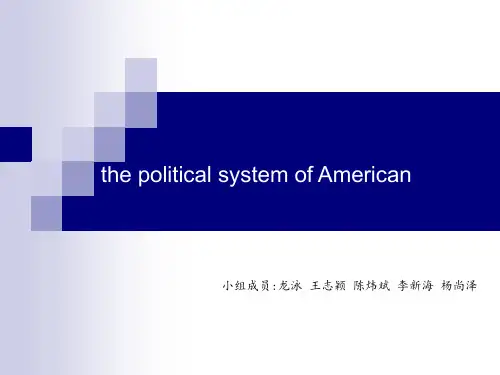
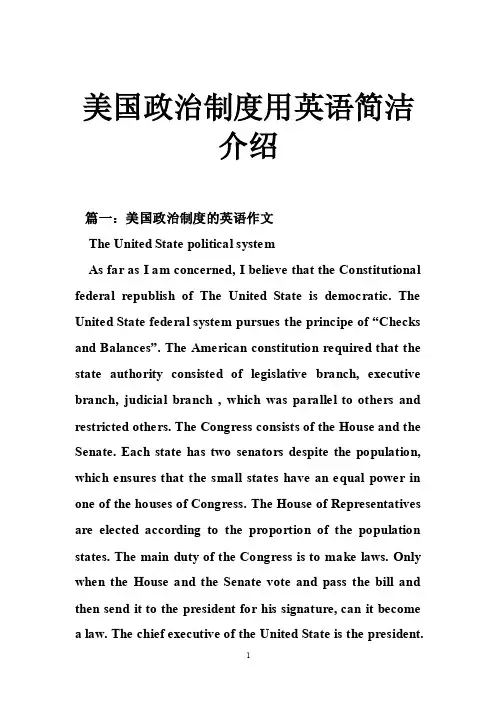
美国政治制度用英语简洁介绍篇一:美国政治制度的英语作文The United State political systemAs far as I am concerned, I believe that the Constitutional federal republish of The United State is democratic. The United State federal system pursues the principe of “Checks and Balan ces”. The American constitution required that the state authority consisted of legislative branch, executive branch, judicial branch , which was parallel to others and restricted others. The Congress consists of the House and the Senate. Each state has two senators despite the population, which ensures that the small states have an equal power in one of the houses of Congress. The House of Representatives are elected according to the proportion of the population states. The main duty of the Congress is to make laws. Only when the House and the Senate vote and pass the bill and then send it to the president for his signature, can it become a law. The chief executive of the United State is the president.He is head of government, commander–in–chief of the armed forces and chief of state. The president is elected by the citizens and he has to be responsible for them. The president can veto the law that the Congressproposes. However,Congress can enact the law despite the president’s views only if two thirds of the members of both houses vote in favour of it. The judicial branch is headed by the Supreme Court. The judges are appointed by the president. The judges can have lifelong tenure if they do not commit a crime.In my opinion, I think that both the presidential election and the enactment of law in the United State are democratic. Thomas Jefferson ever said“As far as I understand it, the supreme power of the most reliable person in charge can only be the people themselves” in 1820. The American system of government represents the citizens benefit and promotes the economic development rapidly.However, the American system has also existed disadvantages. I think the racial prejudice is a serious problem in American society. A 18‐year‐old black youth named Michael Brown was shot by a white policeman and finally died in Missouri, America on August 9th 2014. whichcaused large‐scale demonstrations and developed the violent incident such as beating,smashing and looting in many places. When the grand jury judgedthat the white policeman can not be accused on November 24th , the protests spread quickly more than 170 cities in America. This issue caused wild public concern not only at home but also all over the world. Unfortunately, the racial problem has not been solved yet.Different from the America, China carried out the system of people’s congress, which fits our country’s situation. In political parties, America has two‐party system but China insists an single‐party system. I think that Chinese system has high efficiency in a short time but has poor long‐term stability, because of lacking power supervision. Instead, American system has low efficiency in short‐term but has high efficiency for a long time. Therefore, we can not say the Chinese system is superior to American system, because they both fit their own country’s situation and have positive impact on the economical development. However,the officials looting has become a more and more serious problem in our country. The officials’duties are serving to the people and doing something beneficial to the public. Butthey failed in their responsibility and looted,which may cause the public feel disappointed to the government. Although the government has taken effective measures to suppress the corruption,officials looting remains a serious problem in our country. So,I think that our government should perfect the power supervision system constantly and prevent the officials from looting. Only by doing this, our country may become better and better.篇二:美国政治制度英文the united state political systemin my opinion, i think that both the presidential election and the enactment of law in the united state are democratic. thomas jefferson ever said“as far as i understand it, the supreme power of the most reliable person in charge can only be the people themselves” in 1820. the american system of government represents the citizens benefit and promotes the economic development rapidly.however, the american system has also existed disadvantages. i think the racial prejudice is a serious problem in american society. a 18‐year‐old black youth named michael brown was shot by a white policeman and finally died in missouri, america on august 9th 2014. whichcaused large‐scale demonstrations and developed the violent incident such as beating,smashing and looting in many places. when the grand jury judgedthat the white policeman can not be accused on november 24th , the protests spread quickly more than 170 cities in america. this issue caused wild public concern not only at home but also all over the world. unfortunately, the racial problem has not been solved yet.the united state political systemin my opinion, i think that both the presidential election and the enactment of law in the united state are democratic. thomas jefferson ever said“as far as i understand it, th e supreme power of the most reliable person in charge can only be the people themselves” in 1820. the american system of government represents the citizens benefit and promotes the economic development rapidly.however, the american system has also existed disadvantages. i think the racial prejudice is a serious problem in american society. a 18‐year‐old black youth named michael brown was shot by a white policeman and finally died in missouri, america on august 9th 2014. which caused large‐scale demonstrations and developed theviolent incident such as beating,smashing and looting in many places. when the grand jury judgedthat the white policeman can not be accused on november 24th , the protests spread quickly more than 170 cities in america. this issue caused wild public concern not only at home but also all over the world. unfortunately, the racial problem has not been solved yet.一、英国政治体制的模式及特点英国的政治制度是典型的君主立宪制,其主要特点是“议会至上”、以内阁为权力核心、君主虚位、政党组织严密。
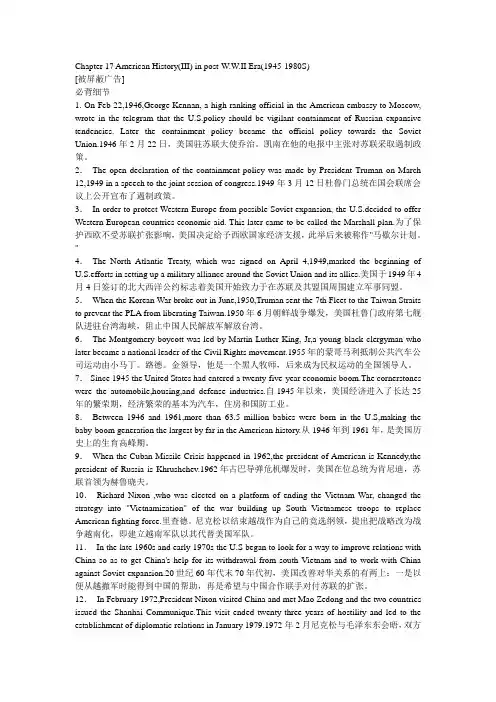
Chapter 17 American History(III) in post-W.W.II Era(1945-1980S)[被屏蔽广告]必背细节1. On Feb 22,1946,George Kennan, a high-ranking official in the American embassy to Moscow, wrote in the telegram that the U.S.policy should be vigilant containment of Russian expansive tendencies. Later the containment policy became the official policy towards the Soviet Union.1946年2月22日,美国驻苏联大使乔治。
凯南在他的电报中主张对苏联采取遏制政策。
2.The open declaration of the containment policy was made by President Truman on March 12,1949 in a speech to the joint session of congress.1949年3月12日杜鲁门总统在国会联席会议上公开宣布了遏制政策。
3.In order to protect Western Europe from possible Soviet expansion, the U.S.decided to offer Western European countries economic aid. This later came to be called the Marshall plan.为了保护西欧不受苏联扩张影响,美国决定给予西欧国家经济支援,此举后来被称作"马歇尔计划。
"4.The North Atlantic Treaty, which was signed on April 4,1949,marked the beginning of U.S.efforts in setting up a military alliance around the Soviet Union and its allies.美国于1949年4月4日签订的北大西洋公约标志着美国开始致力于在苏联及其盟国周围建立军事同盟。
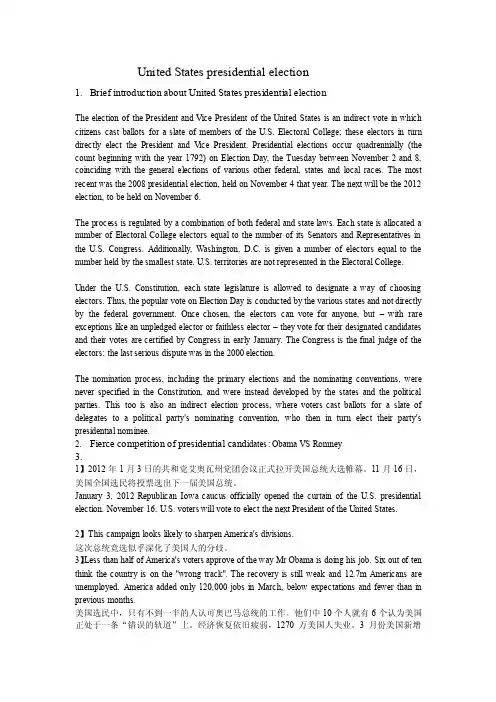
United States presidential election1.Brief introduction about United States presidential electionThe election of the President and Vice President of the United States is an indirect vote in which citizens cast ballots for a slate of members of the U.S. Electoral College; these electors in turn directly elect the President and V ice President. Presidential elections occur quadrennially (the count beginning with the year 1792) on Election Day, the Tuesday between November 2 and 8, coinciding with the general elections of various other federal, states and local races. The most recent was the 2008 presidential election, held on November 4 that year. The next will be the 2012 election, to be held on November 6.The process is regulated by a combination of both federal and state laws. Each state is allocated a number of Electoral College electors equal to the number of its Senators and Representatives in the U.S. Congress. Additionally, Washington, D.C. is given a number of electors equal to the number held by the smallest state. U.S. territories are not represented in the Electoral College.Under the U.S. Constitution, each state legislature is allowed to designate a way of choosing electors. Thus, the popular vote on Election Day is conducted by the various states and not directly by the federal government. Once chosen, the electors can vote for anyone, but –with rare exceptions like an unpledged elector or faithless elector – they vote for their designated candidates and their votes are certified by Congress in early January. The Congress is the final judge of the electors; the last serious dispute was in the 2000 election.The nomination process, including the primary elections and the nominating conventions, were never specified in the Constitution, and were instead developed by the states and the political parties. This too is also an indirect election process, where voters cast ballots for a slate of delegates to a political party's nominating convention, who then in turn elect their party's presidential nominee.2.Fierce competition of presidential cand idates: Obama VS Romney3.1】2012年1月3日的共和党艾奥瓦州党团会议正式拉开美国总统大选帷幕。
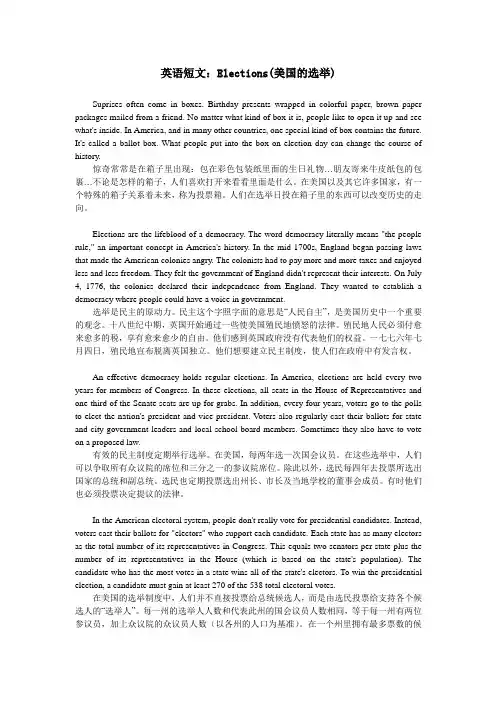
英语短文:Elections(美国的选举)Suprises often come in boxes. Birthday presents wrapped in colorful paper, brown paper packages mailed from a friend. No matter what kind of box it is, people like to open it up and see what's inside. In America, and in many other countries, one special kind of box contains the future. It's called a ballot box. What people put into the box on election day can change the course of history.惊奇常常是在箱子里出现:包在彩色包装纸里面的生日礼物…朋友寄来牛皮纸包的包裹…不论是怎样的箱子,人们喜欢打开来看看里面是什么。
在美国以及其它许多国家,有一个特殊的箱子关系着未来,称为投票箱。
人们在选举日投在箱子里的东西可以改变历史的走向。
Elections are the lifeblood of a democracy. The word democracy literally means "the people rule," an important concept in America's history. In the mid-1700s, England began passing laws that made the American colonies angry. The colonists had to pay more and more taxes and enjoyed less and less freedom. They felt the government of England didn't represent their interests. On July 4, 1776, the colonies declared their independence from England. They wanted to establish a democracy where people could have a voice in government.选举是民主的原动力。
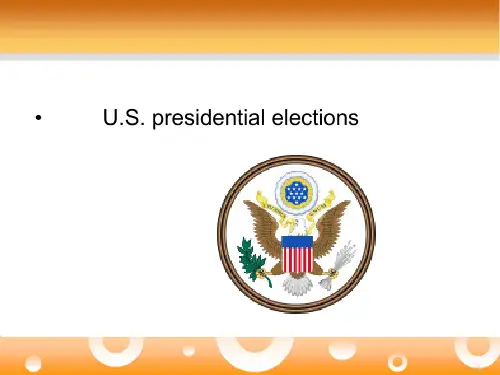

新闻热词英语表达系列之72:“美国总统大选”“美国总统大选”的英文表达为US presidential election。
美国东部时间6日零时,四年一度的美国总统选举投票正式开始,美国新罕布什尔州迪克斯维尔山口的选民率先开始投票,这标志着四年一度的美国总统选举投票正式开始。
美国大多数地区的投票将于美国东部时间6日上午至当日晚间进行,将从美国现任总统奥巴马和马萨诸塞州前州长罗姆尼两人中选出美国第57届总统。
尽管计票工作会持续较长时间,但基本反映选举结果的投票站出口民调结果在6日深夜(北京时间7日中午)将会揭晓。
我们来看相关英文报道:Voters in the tiny New Hampshire town of Dixville Notch cast theirvotes just after midnight (0500 GMT Tuesday), kicking off the quadrennial US presidential election on Tuesday.The town is the first to cast ballots in the nation. Polling stations elsewhere are generally open between morning till nightfall on election day.Only ten voters cast their ballots, and the result showed a tie, with President Barack Obama and Republican presidential nominee Mitt Romney each garnering 5 votes.美国新罕布什尔州小镇迪克斯维尔山口的选民周二零时率先开始投票,标志着四年一度的美国总统大选正式拉开帷幕。
这一小镇是全国率先开始投票的地方,其他地方的投票站也都会在大选日的凌晨至傍晚开放。
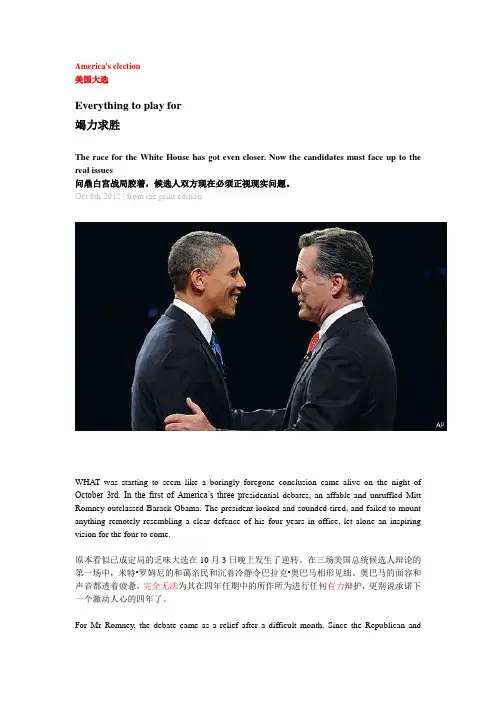
America's election美国大选Everything to play for竭力求胜The race for the White House has got even closer. Now the candidates must face up to the real issues问鼎白宫战局胶着,候选人双方现在必须正视现实问题。
Oct 6th 2012 | from the print editionWHAT was starting to seem like a boringly foregone conclusion came alive on the night of October 3rd. In the first of America’s three pr esidential debates, an affable and unruffled Mitt Romney outclassed Barack Obama. The president looked and sounded tired, and failed to mount anything remotely resembling a clear defence of his four years in office, let alone an inspiring vision for the four to come.原本看似已成定局的乏味大选在10月3日晚上发生了逆转。
在三场美国总统候选人辩论的第一场中,米特•罗姆尼的和蔼亲民和沉着冷静令巴拉克•奥巴马相形见绌。
奥巴马的面容和声音都透着疲惫,完全无法为其在四年任期中的所作所为进行任何有力辩护,更别说承诺下一个激动人心的四年了。
For Mr Romney, the debate came as a relief after a difficult month. Since the Republican andDemocratic conventions there has been a sizeable poll bounce for Mr Obama, but nothing of the sort for Mr Romney. Two PR disasters took their toll in September. In one, the Republican contrived to sound petty and unstatesmanlike just as news was breaking that the American ambassador to Libya had been murdered by extremists; in another, the rich businessman appeared to have written off 47% of the country as useless parasites who would vote for his opponent because they did not pay income tax.这场辩论使罗姆尼在一个月艰难竞选后终于松了一口气。
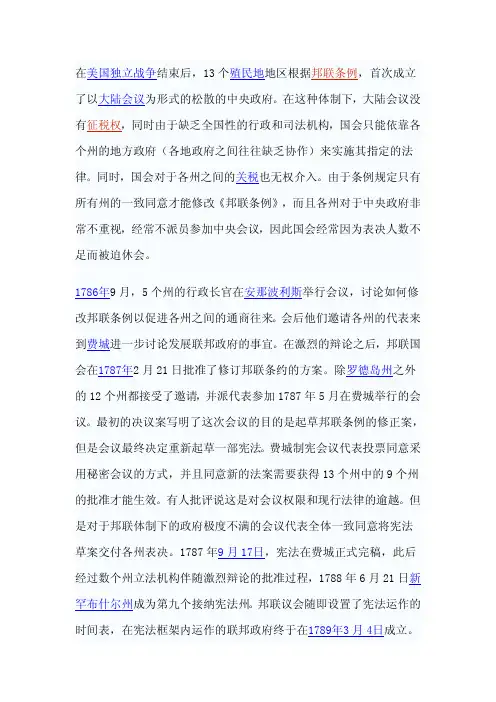
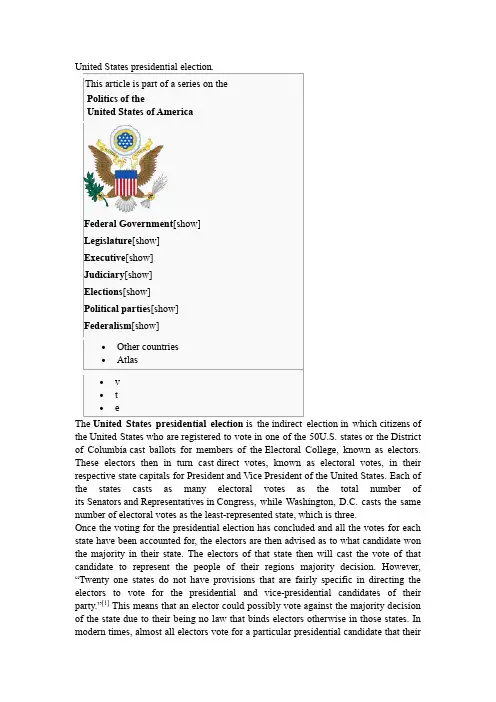
election in which citizens of the United States who are registered to vote in one of the 50U.S. states or the District of Columbia cast ballots for members of the Electoral College, known as electors. These electors then in turn cast direct votes, known as electoral votes, in their respective state capitals for President and Vice President of the United States. Each of the states casts as many electoral votes as the total number of its Senators and Representatives in Congress, while Washington, D.C. casts the same number of electoral votes as the least-represented state, which is three.Once the voting for the presidential election has concluded and all the votes for each state have been accounted for, the electors are then advised as to what candidate won the majority in their state. The electors of that state then will cast the vote of that candidate to represent the people of their regions majority decision. However, “Twenty one states do not have provisions that are fairl y specific in directing the electors to vote for the presidential and vice-presidential candidates of their party.”[1] This means that an elector could possibly vote against the majority decision of the state due to their being no law that binds electors otherwise in those states. In modern times, almost all electors vote for a particular presidential candidate that theirstates majority decided upon; thus, the results of the election can generally be determined based on the state-by-state popular vote. The candidate who receives an absolute majority of electoral votes for President or Vice President (currently, at least 270 out of a total of 538) is then projected to be elected to that office. If no candidate receives an absolute majority of electoral votes for President, the House of Representatives chooses the President; if no candidate receives an absolute majority for Vice President, the Senate chooses the Vice President.These presidential elections occur quadrennially. Registered voters cast their ballots on Election Day, which since 1845 has been the Tuesday after the first Monday in November (i.e.,the first Tuesday after November 1),[2][3][4] coinciding with the general elections of various other federal, state, and local races. The Electoral College electors then schedule to formally cast their electoral votes on the first Monday after the second Wednesday of December (i.e., the first Monday after December 12) at their respective state capitals. Congress then certify the results in early January, and the presidential term begins on Inauguration Day, which since the passage of the Twentieth Amendment has been set at January 20.The Electoral College and its procedure is established in the U.S. Constitution by Article II, Section 1, Clauses 2 and 4; and the Twelfth Amendment(which replaced Clause 3 after it was ratified in 1804). Under Article II, Section 1, Clause 2, the manner for choosing electors is determined by each state legislature, not directly by the federal government. Many state legislatures used to select their electors directly instead of using any form of popular vote, but the political parties in the various states now conduct their own separate elections to help choose their slate of electors. The Twenty-third Amendment, ratified in 1961, then granted electoral votes to Washington, D.C. Electors can vote for anyone, butunpledged electors or faithless electors have been rare in modern times.The nomination process, consisting of the primary elections and caucuses and the nominating conventions, was not specified in the Constitution, but was developed over time by the states and thepolitical parties. These primary elections are generally held between January and June before the general election in November, while the nominating conventions are held in the summer. This too is an indirect election process, one in which voters in the various states, the District of Columbia, as well as those in U.S. territories, cast ballots for a slate of delegates to a political party's nominating convention, who then in turn elect their party's presidential nominee. Each party's presidential nominee or the convention may then choose a vice presidential running mate to join with him or her on the same ticket, and this choice is often rubber-stamped by the conventions, depending on that convention's rules. Because of changes to national campaign finance laws since the 1970s regarding the disclosure of contributions for federal campaigns, presidential candidates from the major political parties usually declare their intentions to run as early as the spring of the previous calendar year before the election (almost 18 months before Inauguration Day).[5]A 2016 general election ballot, listing the presidential and vice presidential candidates Contents[hide]∙1History∙2Procedureo 2.1Eligibility requirementso 2.2Nominating processo 2.3The popular vote on Election Dayo 2.4Electoral collegeo 2.5Election calendar∙3Trendso 3.1Previous experienceo 3.2Technology and media∙4Criticismso 4.1Proposed changes to the election process∙5Electoral college results∙6V oter turnout∙7Financial disclosures∙8Presidential coattailso8.1Comparison with other U.S. general elections∙9See also∙10Notes∙11External linksHistory[edit]Article Two of the United States Constitution originally established the method of presidential elections, including the Electoral College. This was a result of a compromise between those constitutional framers who wanted the Congress to choose the president, and those who preferred a national popular vote.[6]Each state is allocated a number of electors that is equal to the size of its delegation in both houses of Congress combined. With the ratification of the 23rd Amendment to the Constitution in 1961, the District of Columbia is also granted a number of electors, equal to the number of those held by the least populous state. However, U.S. territories are not represented in the Electoral College.Constitutionally, the manner for choosing electors is determined within each state by its legislature. During the first presidential election in 1789, only 6 of the 13 original states chose electors by any form of popular vote.[7] Gradually throughout the years, the states began conducting popular elections to help choose their slate of electors, resulting in the overall, nationwide indirect election system that it is today.Under the original system established by Article Two, electors could cast two votes to two different candidates for president. The candidate with the highest number of votes (provided it was a majority of the electoral votes) became the president, and the second-place candidate became the vice president. This presented a problem during the presidential election of 1800 when Aaron Burrreceived the same number of electoral votes as Thomas Jefferson and challenged Jefferson's election to the office. In the end, Jefferson was chosen as the president because of Alexander Hamilton's influence in the House of Representatives. This added to the deep rivalry between Burr and Hamilton which resulted in their famous 1804 duel.In response to the 1800 election, the 12th Amendment was passed, requiring electors to cast two distinct votes: one for President and another for Vice President. While this solved the problem at hand, it ultimately had the effect of lowering the prestige of the Vice Presidency, as the office was no longer for the leading challenger for the Presidency. The separate ballots for President and Vice President became something of a moot issue later in the 19th century when it became the norm for popular elections to determine a state's Electoral College delegation. Electors chosen this way are pledged to vote for a particular presidential and vice presidential candidate (offered by the same political party). So, while the Constitution says that the President and Vice President are chosen separately, in practice they are chosen together.The 12th Amendment also established rules when no candidate wins a majority vote in the Electoral College. In the presidential election of 1824, Andrew Jackson received a plurality, but not a majority, of electoral votes cast. The election was thrown to the House of Representatives, and John Quincy Adams was elected to the presidency. A deep rivalry resulted between Andrew Jackson and House Speaker Henry Clay, who had also been a candidate in the election.Since 1824, aside from the occasional "faithless elector," the popular vote determines the winner of a presidential election by determining the electoral vote, as each state or district's popular vote determines its electoral college vote. Although the nationwide popular vote does not directly determine the winner of a presidential election, it does strongly correlate with who is the victor. In 52 of the 56 total elections held so far (about 93 percent), the winner of the national popular vote has also carried the Electoral College vote. The winners of the nationwide popular vote and the Electoral College vote differ only in close elections. In highly competitive elections, candidates focus on turning out their vote in the contested swing states critical to winning an electoral college majority, so they do not try to maximize their popular vote by real or fraudulent vote increases in one-party areas.[8]However, candidates can fail to get the most votes in the nationwide popular vote in a Presidential election and still win that election. In the 1824 election, Jackson won the popular vote, but no one received the majority of electoral votes. According to the12th Amendment in the Constitution, the House of Representatives must choose the president out of the top 3 people in the election. Clay had come fourth, so he threw his support to Adams, who then won. Because Adams later named Clay his Secretary of State, Jackson's supporters claimed that Adams gained the presidency by making a deal with Clay. Charges of a "corrupt bargain" followed Adams through his term.Comparison of the popular vote totals since 1900.RepublicanDemocratAll other candidates togetherThen in 1876, 1888, 2000, and 2016, the winner of electoral vote lost the popular vote outright. Numerous constitutional amendments have been submitted seeking to replace the Electoral College with a direct popular vote, but none has ever successfully passed both Houses of Congress. Another alternate proposal is the National Popular V ote Interstate Compact, an interstate compact whereby individual participating states agree to allocate their electors based on the winner of the national popular vote instead of just their respective statewide results.The presidential election day was established on a Tuesday in the month of November because of the factors involved (weather, harvests and worship). When voters used to travel to the polls by horse, Tuesday was an ideal day because it allowed people to worship on Sunday, ride to their county seat on Monday, and vote on Tuesday–all before market day, Wednesday. The month of November also fits nicely between harvest time and harsh winter weather, which could be especially bad to people traveling by horse and buggy.[9]Until 1937, presidents were not sworn in until March 4 because it took so long to count and report ballots, and because of the winner's logistical issues of moving to the capital. With better technology and the 20th Amendment being passed, presidential inaugurations were moved to noon on January 20–allowing presidents to start their duties sooner.[9]The Federal Election Campaign Act of 1971 was enacted to increase disclosure of contributions for federal campaigns. Subsequent amendments to law require that candidates to a federal office must file a Statement of Candidacy with the Federal Election Commission before they can receive contributions aggregating in excess of $5,000 or make expenditures aggregating in excess of $5,000. Thus, this began a trend of presidential candidates declaring their intentions to run as early as the Spring of the previous calendar year so they can start raising and spending the money needed for their nationwide campaign.[5]The first president, George Washington, was elected as an independent. Since the election of his successor, John Adams, in 1796, all winners of U.S. presidential elections have represented one of two major parties. Third parties have taken secondplace only twice, in 1860 and 1912. The last time a third (independent) candidate achieved significant success (although still finishing in third place) was in 1992, and the last time a third-party candidate received any electoral votes not from faithless electors was in 1968.Procedure[edit]Eligibility requirements[edit]The hand-written copy of the natural-born-citizen clause as it appeared in 1787 Article Two of the United States Constitution stipulates that for a person to serve as President, the individual must be a natural-born citizen of the United States, at least35 years old, and a resident of the United States for a period of no less than 14 years.A candidate may start running his or her campaign early before turning 35 years old or completing 14 years of residency, but must meet the age and residency requirements byInauguration Day. The Twenty-second Amendment to the Constitution also sets a term limit: a President cannot be elected to more than two terms.The U.S. Constitution also has two provisions that apply to all federal offices in general, not just the presidency. Article I, Section 3, Clause 7 states that if the U.S. Congress convicts any officer on impeachment, they may also bar that person from holding any public office in the future. And Section 3 of the Fourteenth Amendment prohibits the election to any federal office of any person who had held any federal or state office and then engaged in insurrection, rebellion or treason; this disqualification can be waived if such an individual gains the consent of two-thirds of both houses of Congress.In addition, the Twelfth Amendment establishes that the Vice-President must meet all of the qualifications of being a President.Although not a mandatory requirement, Federal campaign finance laws including the Federal Election Campaign Act state that a candidate who intends to receive contributions aggregating in excess of $5,000 or make expenditures aggregating in excess of $5,000, among others, must first file a Statement of Candidacy with the Federal Election Commission.[10] This has led presidential candidates, especially members from the two major political parties, to officially announce their intentions to run as early as the spring of the previous calendar year so they can start raising or spending the money needed for their nationwide campaign.[5] Potential candidates usually form exploratory committees even earlier to determining the feasibility of them actually running.Nominating process[edit]Main articles: United States presidential primary and United States presidential nominating conventionA 2008 Democratic caucus meeting in Iowa City, Iowa. The Iowa caucuses are traditionally the first major electoral event of presidential primaries and caucuses.Madison Square Garden in New York City, the site of the 1976, 1980, and 1992 Democratic National Conventions; and the 2004 Republican National Convention.The floor of the 2008 Republican National Convention at the Xcel Energy Center in Saint Paul, Minnesota.The modern nominating process of U.S. presidential elections consists of two major parts: a series of presidential primary elections and caucuses held in each state, and the presidential nominating conventions held by each political party. This process was never included in the United States Constitution, and thus evolved over time by the political parties to clear the field of candidates.The primary elections are run by state and local governments, while the caucuses are organized directly by the political parties. Some states hold only primary elections, some hold only caucuses, and others use a combination of both. These primaries and caucuses are staggered generally between January and June before the federal election, with Iowa and New Hampshire traditionally holding the first presidential state caucus and primary, respectively.Like the general election, presidential caucuses or primaries are indirect elections. The major political parties officially vote for their presidential candidate at their respective nominating conventions, usually all held in the summer before the federal election. Depending on each state's law and state's political party rules, when voters cast ballots for a candidate in a presidential caucus or primary, they may be voting to awarddelegates "bound" to vote for a candidate at the presidential nominating conventions, or they may simply be expressing an opinion that the state party is not bound to follow in selecting delegates to their respective national convention.Unlike the general election, voters in the U.S. territories can also elect delegates to the national conventions. Furthermore, each political party can determine how many delegates to allocate to each state and territory. In 2012 for example, the Democratic and Republican party conventions each used two different formulas to allocate delegates. The Democrats-based theirs on two main factors: the proportion of votes each state gave to the Democratic candidate in the previous three presidential elections, and the number of electoral votes each state had in the Electoral College.[11] In contrast, the Republicans assigned to each state 10 delegates, plus 3 delegates per congressional district.[12] Both parties then gave fixed amounts of delegates to each territory, and finally bonus delegates to states and territories that passed certain criteria.[11][12]Along with delegates chosen during primaries and caucuses, state and U.S. territory delegations to both the Democratic and Republican party conventions also include "unpledged" delegates that have a vote. For Republicans, they consist of the three top party officials from each state and territory. Democrats have a more expansive group of unpledged delegates called "superdelegates", who are party leaders and elected officials.Each party's presidential candidate also chooses a vice presidential nominee to run with him or her on the same ticket, and this choice is rubber-stamped by the convention.If no single candidate has secured a majority of delegates (including both pledged and unpledged), then a "brokered convention" results. All pledged delegates are then "released" and are able to switch their allegiance to a different candidate. Thereafter, the nomination is decided through a process of alternating political horse trading, and additional rounds of re-votes.[13][14][15][16]The conventions have historically been held inside convention centers, but since the late 20th century both the Democratic and Republican parties have favoredsports arenas and domed stadiums to accommodate the increasing attendance.The popular vote on Election Day[edit]A Texas voter about to mark a selection for president on a ballot, 2008 Election Day Under the United States Constitution, the manner of choosing electors for the Electoral College is determined by each state's legislature. Although each state designates electors by popular vote, other methods are allowed. For instance, insteadof having a popular vote, a number of states used to select presidential electors by a direct vote of the state legislature itself.However, federal law does specify that all electors must be selected on the same day, which is "the first Tuesday after the first Monday in November," i.e., a Tuesday no earlier than November 2 and no later than November 8.[17] Today, the states and the District of Columbia each conduct their own popular elections on Election Day to help determine their respective slate of electors. Thus, the presidential election is really an amalgamation of separate and simultaneous state elections instead of a single national election run by the federal government.Like any other election in the United States, the eligibility of an individual for voting is set out in the Constitution and regulated at state level. The Constitution states that suffrage cannot be denied on grounds of race or color, sex or age for citizens eighteen years or older. Beyond these basic qualifications, it is the responsibility of state legislatures to regulate voter eligibility.Generally, voters are required to vote on a ballot where they select the candidate of their choice. The presidential ballot is a vote "for the electors of a candidate" meaning that the voter is not voting for the candidate, but endorsing a slate of electors pledged to vote for a specific presidential and vice presidential candidate.Many voting ballots allow a voter t o “blanket vote” for all candidates in a particular political party or to select individual candidates on a line by line voting system. Which candidates appear on the voting ticket is determined through a legal process known as ballot access. Usually, the size of the candidate's political party and the results of the major nomination conventions determine who is pre-listed on the presidential ballot. Thus, the presidential election ticket will not list every candidate running for President, but only those who have secured a major party nomination or whose size of their political party warrants having been formally listed. Laws are in effect to have other candidates pre-listed on a ticket, provided that enough voters have endorsed the candidate, usually through a signature list.The final way to be elected for president is to have one's name written in at the time of election as a write-in candidate. This is used for candidates who did not fulfill the legal requirements to be pre-listed on the voting ticket. It is also used by voters to express a distaste for the listed candidates, by writing in an alternative candidate for president such as Mickey Mouse or comedian Stephen Colbert (whose application was voted down by the South Carolina Democratic Party). In any event, a write-in candidate has never won an election for President of the United States.Because U.S. territories are not represented in the Electoral College, U.S. citizens in those areas do not vote in the general election for President. Guam has held straw polls for president since the 1980 election to draw attention to this fact.[18]Electoral college[edit]Main article: Electoral College (United States)Electoral College map showing the results of the 2016 U.S. presidential election. Republican candidate Donald Trump won the popular vote in 30 states (denoted in red) to capture 305 electoral votes (plus 1 electoral vote from Maine's second congressional district). Democraticcandidate Hillary Clinton won the popular vote in 20 states and Washington, D.C. (denoted in blue) to capture 232 electoral votes.Most state laws establish a winner-take-all system, wherein the ticket that wins a plurality of votes wins all of that state's allocated electoral votes, and thus has their slate of electors chosen to vote in the Electoral College. Maine and Nebraska do not use this method, instead giving two electoral votes to the statewide winner and one electoral vote to the winner of each Congressional district.Each state's winning slate of electors then meets at their respective state's capital on the first Monday after the second Wednesday in December to cast their electoral votes on separate ballots for President and Vice President. Although Electoral College members can technically vote for anyone under the U.S. Constitution, 24 states have laws to punish faithless electors,[19] those who do not cast their electoral votes for the person whom they have pledged to elect.In early January, the total Electoral College vote count is opened by the sitting Vice President, acting in his capacity as President of the Senate, and read aloud to a joint session of the incoming Congress, which was elected at the same time as the President.If no candidate receives a majority of the electoral vote (at least 270), the President is determined by the rules outlined by the 12th Amendment. Specifically, the selection of President would then be decided by a contingent election in a ballot of the House of Representatives. For the purposes of electing the President, each state has only one vote. A ballot of the Senate is held to choose the Vice President. In this ballot, each senator has one vote. The House of Representatives has chosen the victor of the presidential race only twice, in 1800 and 1824; the Senate has chosen the victor of the vice-presidential race only once, in 1836.If the President is not chosen by Inauguration Day, the Vice President-elect acts as President. If neither are chosen by then, Congress by law determines who shall act as President, pursuant to the 20th Amendment.Unless there are faithless electors, disputes, or other controversies, the events in December and January mentioned above are largely a formality since the winner canbe determined based on the state-by-state popular vote results. Between the general election and Inauguration Day, this apparent winner is referred to as the "President-elect" (unless it is a sitting President that has won re-election).Election calendar[edit]The typical periods of the presidential election process are as follows, with the dates corresponding to the 2016 general election:∙Spring 2015 – Candidates announce their intentions to run, and (if necessary) file their Statement of Candidacy with the Federal Election Commission ∙August 2015 to March 2016 – Primary and caucus debates∙February 1 to June 14, 2016 – Primaries and caucuses∙April to August, 2016 – Nominating conventions (including those of the minor third parties)∙September and October, 2016 – Presidential election debates∙November 8, 2016 – Election Day∙December 19, 2016 – Electors cast their electoral votes∙January 6, 2017 – Congress counts and certifies the electoral votes∙January 20, 2017 – Inauguration DayTrends[edit]Previous experience[edit]See also: List of Presidents of the United States by previous experience and List of Presidents of the United States by other offices heldJohn Adams was the first of a record-high 26 presidents who had been lawyersA number of trends in the political experience of presidents have been observed. Between 1956 and the last completed 2012 election, the presidential nominees of both major parties have been either incumbent presidents seeking re-election, sitting or former vice presidents, sitting or former U.S. Senators, or sitting or former state Governors.Fourteen Presidents have served as Vice President. However, only John Adams (1796), Thomas Jefferson (1800), Martin Van Buren (1836), Richard Nixon (1968) andGeorge H. W. Bush (1988) began their first term after winning an election. Among the remaining nine who began their first term as President according to thepresidential line of succession after their respective predecessor died or resigned from office, Theodore Roosevelt, Calvin Coolidge, Harry S. Truman, andLyndon B. Johnson were reelected. John Tyler, Millard Fillmore, Andrew Johnson, Chester A. Arthur, and Gerald Ford served as President but became president through succession and not election. Ford became President after Nixon's resignation in 1974 through the processes of the Twenty-fifth Amendment and then lost the 1976 presidential election, making him the only President to have not to have been elected to national office. Sixteen presidents had served in the Senate, including four of the five Presidents who served between 1945 and 1974. However, only three were sitting U.S. Senators at the time they were elected president (Warren G. Harding in 1920, John F. Kennedy in 1960, and Barack Obama in 2008). Major-party candidate Senators Andrew Jackson (1824), Lewis Cass (1848), Stephen Douglas (1860), Barry Goldwater (1964), George McGovern (1972), John Kerry (2004), and John。

英语短文:Elections(美国的选举)Suprises often come in boxes. Birthday presents wrapped in colorful paper, brown paper packages mailed from a friend. No matter what kind of box it is, people like to open it up and see what's inside. In America, and in many other countries, one special kind of box contains the future. It's called a ballot box. What people put into the box on election day can change the course of history.惊奇常常是在箱子里出现:包在彩色包装纸里面的生日礼物…朋友寄来牛皮纸包的包裹…不论是怎样的箱子,人们喜欢打开来看看里面是什么。
在美国以及其它许多国家,有一个特殊的箱子关系着未来,称为投票箱。
人们在选举日投在箱子里的东西可以改变历史的走向。
Elections are the lifeblood of a democracy. The word democracy literally means "the people rule," an important concept in America's history. In the mid-1700s, England began passing laws that made the American colonies angry. The colonists had to pay more and more taxes and enjoyed less and less freedom. They felt the government of England didn't represent their interests. On July 4, 1776, the colonies declared their independence from England. They wanted to establish a democracy where people could have a voice in government.选举是民主的原动力。
Presidentialelection美国总统选举流程,英文介绍第一篇:Presidential election美国总统选举流程,英文介绍美国总统选举流程美国总统选举每四年举行一次。
总统选举的程序分为预选、党的全国代表大会、总统候选人竞选、全国选民投票选出总统“选举人”和“选举人”成立选举人团正式选举总统5个阶段进行,整个程序需耗费近一年的时间。
预选方式主要有两种:一种是像艾奥瓦州那样,由各党从基层选区开始,自下而上逐级选出出席县、州和全国代表大会的代表;另一种是像新罕布什尔州那样,由各党的选民在同一天到投票站秘密投票,分别选举各自支持的总统候选人,然后根据各候选人的得票比例确定该州参加各党全国代表大会的代表人数。
第二种方式比较正规,绝大部分州都采用这一方式。
各党的全国代表大会一般在7、8月份举行,主要任务是确定该党的总统、副总统候选人,并通过党的竞选纲领。
此后,总统竞选便正式展开,各党的总统候选人开始疯狂拉票,这一过程一般持续8周-9周。
全国选民投票是在选举年11月份的第一个星期一后的第一个星期二举行,这天也叫总统大选日。
由于美国总统选举实行选举人团制度,因此总统大选日实际上是选举代表选民的“选举人”。
真正的总统选举,在选举年12月第二个星期三之后的第一个星期一举行。
届时,各州被推选出的“选举人”将最终选出新总统,当选总统将在次年1月20日宣誓就职。
U.S.presidential election processU.S.presidential elections are held every four years.Presidential election procedure is divided into pre-selection of the party's National People's Congress, presidential candidates campaign, the national voters elected president “electors” and “electors” the establishment of the Electoral College formally elected president five stages, the entire program would entailnearly ayear's time.Preselection mode, there are two: one is like Iowa did, by the party from the grass-roots constituency, the bottom-up level by level elected to attend the county, state, and representatives of the National People's Congress;another is like New Hampshire as, by the party's voters to the polls by secret ballot on the same day, respectively election respective support presidential candidate, then determined according to the proportion of the votes of the candidates in the state to participate in each party's number of representatives of the National People's Congress.The second approach is more formal, the vastmajority of states in this manner.Each party's National People's Congress is held usually in July and August, the main task is to determine the party's presidential and vice presidential candidates, and the party's election platform.Since then, the presidential campaign was launched, the party's presidential candidate began to franticallycanvassing, a process that typically lasts eight weeks-9 weeks.National voters in an election year in November, the first Monday after the first one held on Tuesday, this day is also called the presidential election date.As the U.S.presidential election in the implementation of the electoral college system, the date of the presidential election is actually “electors” election on behalf of the voters.The truly presidential election, the first election year in December following the second Wednesday held Monday.In that time, the states pushed elect “electors” will eventually elect a new president, the president-elect will be sworn in on January 20 of the following year.第二篇:浅谈2012美国总统选举浅谈2012美国总统选举-----奥巴马的胜利摘要:在2012美国总统选举中,奥巴马与罗姆尼竞争总统位置,在经过一系列的选举过程后,奥巴马的投票总数略胜一筹,成功连任。